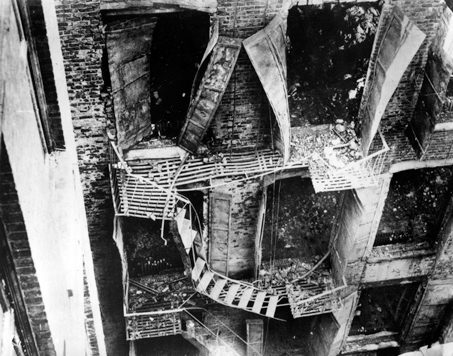In the last 100+ years, the US has experienced dozens of tragic events with large numbers of fatalities, many of which have taught us important lessons and motivated changes to life safety codes. Someone recently emailed me to say that he had read a book about one of these tragedies, and thought everyone in the industry should study and learn from the past. I couldn’t agree more – as I mentioned about a year ago, I learned a lot by reading a book about the shooting at Columbine High School, and applied that information to suggestions about compartmentalizing schools and other buildings.
This week marks the anniversary of a very tragic fire that had major impacts on life safety codes – the 1911 fire at the Triangle Shirtwaist Factory in New York. I read a book about this fire years ago – Triangle, The Fire That Changed America by David Von Drehle. In fact, it was one of the few books that survived the big purge and made the move with me 4 years ago. As I read, I marked these paragraphs describing the desperate attempts of the garment workers to escape the fire:
Louis Brown yanked and pulled and bulled his way through the crowd piled up at the door. The problem was obvious: stairway doors in the Asch Building were designed to swing inward, because the stairway landings were too narrow to accommodate outward-swinging doors. But the workers were jammed so tightly against this one, and thronged so thickly against one another, that the door couldn’t possibly open. “You couldn’t get it no tighter,” Brown recounted. Compounding the crisis, it was possible that the door was actually locked. Brown wouldn’t know for sure until he managed to reach it.
Ida Cohen, a sewing machine operator, was right up against the door. “All the girls was falling on me and they squeezed me to the door,” she remembered. It was made of wood, with a top panel of wired glass. Cohen’s face was being pressed against the glass, tighter and tighter, until she imagined that the churning mass behind her would shove her right through. “Please girls, let me open the door!” she gasped once, twice, three times. She prepared for the awful feeling of glass slicing into her face. “And then Mr. Brown came there and pushed the girls away on one side.”
By brute force, Brown cleared a bit of space. He fumbled with a key in the lock, and somehow managed to open the door. Scores of terrified young people flooded down the stairs.
Today’s codes include many life-safety features that would have impacted the outcome of the Triangle Shirtwaist Factory fire – hardware that allows free egress, outswinging doors, walls and opening protectives with a fire-protection rating, not to mention automatic sprinkler systems and fire alarms. All of these products and systems were available at the time of the Triangle fire, but they were not implemented in the Asch Building. With prioritization of security over life safety that I’m currently seeing in some schools and other facilities, I fear that we may be taking steps backward with regard to safety.
I urge you to learn more about the Triangle fire and other historic events that have impacted our industry. History.com has an article this week with a lot of links to additional information, as well as the video embedded below. Cornell University has a comprehensive website about the fire, and OSHA has a page with links to more resources. If you find other good sources of information, feel free to leave them in the reply box.
Photo: OSHA
You need to login or register to bookmark/favorite this content.






Lori,
NFPA 101, The Life Safety Code is a direct result of this fire!!